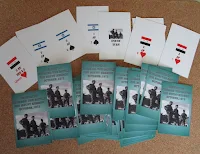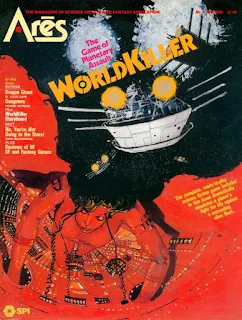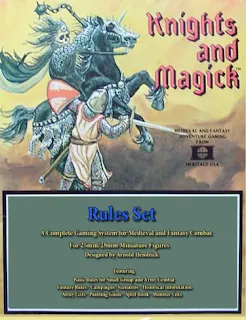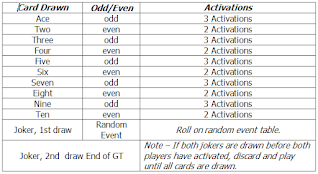Up for a review is an oldie but goodie game from 2016. Small, easy to play and fun, read on if you like...
Title: Sound and Fury, The Battle for Mechili, January 24/25, 1941
Price: $*
Designer: Paul Rohrbaugh
Graphics Designer: Ilya Kudriashov
Publisher: High Flying Dice Games
Published Date: 2016
Subject: The battle around the cross-roads of Ft Mechili 1941.
A Little bit of history: Italy declared war on Britain and France on 10 June 1940. During the next few months there were raids and skirmishes between Italian 10th Army in Libya and the British Commonwealth forces in Egypt. The Italians planned for the invasion of Egypt with the goal of removing the British and to capture the Suez Canal, code name "Operazione E". After numerous delays, "Operazione E" commenced on 13 September 1940 and began the Western Desert Campaign, which lasted from 1940 to 1943.
The Italian strategy was to advance from Libya along the Egyptian coast to seize the Suez Canal, the scope of the offensive was reduced to an advance as far as Sidi Barrani and the engagement of any British forces in the area.
As the 10th Army advanced, a small British force at Sollum withdrew to the main defensive position east of Mersa Matruh. The Italian advance was harassed by the 3rd Coldstream Guards with attached artillery and other units. After recapturing Fort Capuzzo, the Italians advanced approximately 95 km (59 mi) in three days and on 16 September, the advance stopped at Maktila, 16 km (10 mi) beyond Sidi Barrani.
The 10th Army dug in and awaited reinforcements and supplies along the Via della Vittoria, an extension of the Litoranea Balbo (Via Balbia) being built from the frontier. Five fortified camps were built around Sidi Barrani from Maktila, 24 km (15 mi) east along the coast, south to Tummar East, Tummar West and Nibeiwa; another camp was built at Sofafi on the escarpment to the south-west
General Wavell, following the 10th Army advance, ordered the commander of British Troops Egypt, Lieutenant-General Sir Henry Maitland Wilson to plan a limited operation to push the Italians out of Egypt back into Libya, was given the code name "Operation Compass" and was originally planned as a five-day raid, but consideration was given to continuing the operation to exploit any success.
Attacking on December 8, 1940, the British Commonwealth forces units struck at Sidi Barrani exploiting a gap in the 10th Army's defenses, attacked south of Sidi Barrani and achieved complete surprise. Supported by artillery, aircraft, and armor, the assault overran the Italian position within five hours and resulted in the destruction of the Maletti Group and the death of its commander, General Pietro Maletti.
Over the next three days, the British pushed west destroying equipment and capturing 38,300 men. Moving through Halfaya Pass, they crossed the border and captured Fort Capuzzo.
Wishing to exploit the situation, O'Connor wanted to keep attacking, however he was forced to halt as his superior, General Archibald Wavell, withdrew the 4th Indian Division from the battle for operations in East Africa. This unit was replaced on December 18 by the raw Australian 6th Division, the first time Australian troops saw combat in World War II. Resuming the advance, the British were able to keep the Italians off balance with the speed of their attacks which led to entire units being cut off and forced to surrender.
Continuing the attack, the British wanted to finish what they started - destroying the remainder of the Italian 10 Army, which was retreating from Cyrenaica.
Pushing into Libya, the Australians captured Bardia (January 5, 1941), Tobruk (January 22). After the fall of Bardia and Tobruk in 1941, the British forces was split with the 6th Australian Infantry Division heading towards Derna, along the coast road and was temporarily halted by the 60th Infantry Division "Sabratha" reinforced by the Libyan paratrooper battalion "Ascari del Cielo" and reserve units.
Meanwhile the 7th Armoured Division going south approached Mechili, a crossroads of strategic importance. On 24 January, a squadron of light tanks from the 7th Hussars headed to the west to cut the track linking Derna and Mechili (north of Mechili) and ran into the new M13/40 Italian tanks of the Ragguppamento 'Babini'.
Ragguppamento 'Babini' attacked the 7th Hussars (composed of 26 Mk VI light tanks and one cruiser tank), destroying six Mk VI light tanks and forcing the others to retreat. The British was able to knock out 2 M13/40s.
The 7th Hussars promptly pulled back, calling for the assistance of the 2nd Royal Tank Regiment which ignored the call for assistance, until eventually someone got their butt kick and the 2nd Royal Tank Regiment got under way catching the Italian tanks that were sky-lined on a ridge, knocking out seven of them for the loss of one cruiser and six Mk VIs.
The principle armour of each antagonist during this battle: For the Italians this was the CV35 tankette (these are the Fiat Ansaldo 35 in the game. Developed from the Carden-Lloyd Mk VI tankette Italy bought in 1929), possibly the M11/39 (though most were probably destroyed in previous battles at the start of Operation Compass) and of course this was the debut of the M13/40.
The British used the Carden-Lloyd Mk VI's tankette and various Marks of Cruiser tanks (I, II, IIA). Being lightly armoured, the tankettes were death traps to both sides as they were brutally destroyed.
Abbreviations that may be used: AF= attack factor, DF= Defense factor, MF= movement factor, VP= victory point, 1D6=one die six sided, CD= card draw, Mk= mark, AT= anti-tank gun, GD= graphics designer, INF= infantry, AC= armoured car, ACTS= activation (what a player can do), ML= morale level, BP= British Player, IP= Italian Player.
Components and Physical Quality: Though the game is a few years old, the graphics are what I would consider "very good gaming graphics" and brought to us courtesy of Ilya Kudriashov, who (IMHO) is one of the top game graphic designers around and in my top 5 of the best GDs out there (that knowledge and $45 should be able to buy you a cup of tea or coffee, but not a beer, anywhere in the world).
There are 56 unmounted double sided counters, .5" in size, and use a combination of NATO symbols and side views of the various armour used. Each counter is composed of the AF-DF-MF with Armour and AT guns having a "red" AF. Not all armour has a "red" AF.
The game map is 11"x17" in size, but honestly, the playing area is only 8"x10" with .5" letter/numbered hexes. Shaded in 2 colours, to represent the terrain levels (level 1 and level 2) with Mechilli in the middle. The sand is shaded with various dots. I would hate to be the GD as I would be blinded by having to place all those dots. 😊
The rest of the game map has the various turn tracks, the Morale & Support track, and a VP track. There is also a terrain chart listing the movement costs and a unit breakdown chart.
Amount of counters and breakdown: For the British, there are 8 British armour, 3 inf, 1 AT, 1 VP marker, 1 arty support marker, 1 air strike support marker, 1 air strike target marker, 1 arty target marker, and 1 morale marker for a total of 18 counters.
 For the Italians: 4 armour, 1 AC, 6 inf, 2 AT, 1 morale marker, 1 VP marker, 1 arty support marker, 1 arty target marker, 1 air strike support marker, and 1 air strike target marker , for a total of 19 counters. In addition, there are 17 "pinned" and "entrenched" (flip side) markers, 1 game turn marker, and 1 "Fog of War" marker, all total 56 counters.
For the Italians: 4 armour, 1 AC, 6 inf, 2 AT, 1 morale marker, 1 VP marker, 1 arty support marker, 1 arty target marker, 1 air strike support marker, and 1 air strike target marker , for a total of 19 counters. In addition, there are 17 "pinned" and "entrenched" (flip side) markers, 1 game turn marker, and 1 "Fog of War" marker, all total 56 counters.
Addenda: Why yes, yes therre is. 😏
There is one extra addenda not mentioned - The British has two x1 VP markers. The British VP marker needs an x10 on it's flip side. Just add a "0" and it is fixed.
Of course, here some 8 years later, the addenda has been incorporated into the rules, but just in case you bought yours back in 2016-17, here it is for you.
Player Supplied Components: Players will need to provide a 1D6 and a deck of cards. If you are a fan (or not) of HFDG card sets, good news as this game has a set available. For $11.00 one can have a fantastic card set designed by Ilya. Just contact HFDG when you order the game. Better yet, order 4 games from HFDGs and get this card set for free. 😉
And of course, one will have to mount the counters, unless you opt to have this done for you. Not sure of the cost, but it is available. You will still have to cut them out. Mounting and cutting counters is easy to do and if you need help, there is a short review on this blog that explains how to do this, safely. Go here.
Complexity: The game is considered introductory and yes, it is. But like most games from HFDG there are variant rules to increase the difficulty. I would suggest that after a few plays to get the game down, add all of the variant rules. Just remember to read the rules. Don't add to them or over think the rules as most gamers do. Just go by what the rules say. (see 12.0, 12.1, 12.2, and 12.3)
Playing Time: Between 60 minutes to 120 minutes. Of course play could last longer or shorter, just depends on how fast folks get thru the deck of cards.
Rules: Ah yes, the rules. Only 6 pages of rules, written in the standard high quality one comes to expect from High Flying Dice Games.
Setup: A standard deck of cards with 2 jokers and with all face cards removed or just use the card set for this game. Divide the deck into black and red cards with 1 joker for each player. Italians (black deck) set up first then the Brits (red deck). With only 12 units on the British side and 13 for the Italians, setup is a breeze, maybe 2 minutes?(see 2.0, 2.1, 2.2, 2.3)
Game Play: 8 turns of game play with each turn divided into rounds.
In this game play, the highest card drawn wins the round and the winner gets to preform a number of acts. If the winning player's card is odd, then that player gets 3 acts. If an even card, then 2 acts. If the CD is a tie, then the player who did not perform any acts in the last previous round can perform 2 acts. If a joker is drawn, the player rolls on the random events table (last page of the rules).
When the 2nd joker is turned over, the game turn is over with no one getting any acts. Move the game turn marker to the next turn, reshuffle the decks and then resume the game, unless it is the last turn of the game. (see 3.0 and Random Events when the 1st joker is turned over).
As with all good things, in case the 2nd joker is drawn before all players have activated at least once, discard the joker and continue play until all cards have been used.
The game can be won by several methods. If, before the game has ended on the last turn, either player can claim an automatic victory by reducing their opponent's ML to 0 (zero) (See 9.0) or if not, on the last game turn the winner is declared by victory points. (see 11.0)
Activations: Each act allows either player to do one of the following with 1 unit (see 3.1):
1) arty support (see 5.0)
2) air support (see 6.0)
3) move (see 3.2 and 4.2)
4) assault (combat) (see 4.0, 4.1, and 4.2. If using variant rules 12.1, 12.2, 12.3)
5) entrench (only inf and at units only) (see 7.0 and 4.2)
6) rally (see 8.0 and 4.2)
Note - Basically, one can either do arty support, air support, entrench a unit or rally, moved a unit or assault with a unit. For example you cannot move a unit then attack with the same unit, even if you have more than 1 act available. One will have to wait till the next CD win to move or attack with that unit, again.
GT1 first Activation: The British has the first activation of Game Turn 1. BP rolls 1D6 to see how many activations are allowed. After these acts are preformed, begin the normal CD. (see 2.2 and 3.0)
Movement: When moving units via the movement act, units must stop when entering a hex adjacent to an un-pinned enemy unit. Units may not stack, but may retreat thru a hex occupied by a friendly unit, up to it's MF. (see 3.2 and 4.1)
Pinned Effects: Units that are "pinned" cannot activate except to "rally". The pinned marker is removed at the end of each turn, not round. (see 4.2)
Special mention for "assault": Armour and AT units can attack enemy armour up to 2 hexes away and up to 3 hexes away if the armour or AT unit's AF is red and the attacking armour unit is on level 2 terrain and the defending unit is on a level 1 hex.
To figure out the assault, roll 1D6 and modify the DR as follow (and use all that apply):
+? Attacking unit's AF
-1 Target unit in village hex or entrenched(-2 maximum)
+1 Firing unit is in level 2 and firing on unit in a level 1 hex.
+1 Red AF unit firing on "pinned" armour unit.
-1 Target unit is not adjacent
+1 firing through target unit's rear aspect (if playing with variant rule 12.1).
If the modified DR is < (less than or equal to) targeted unit's DF nothing happens.
If the modified DR is < (less than or equal to) 0 the attacking unit is also marked as "pinned".
If the modified DR is > (greater than) the target unit's DF, one of these can happen:
- If target unit was "Un-Pinned" it is marked as "Pinned". Place a pinned marker on it. (see 4.2)
- If the target unit was "Pinned", it must immediately retreat or take a step loss (reduced). Defending player's choice. (see 4.1 and 4.2)
- A unit unable to retreat must take a step loss. A unit already reduced and must take a step loss or only has one step, is eliminated and removed from the game. Don't forget to change the "Morale Level" track. (see 4.1, 9.0, and 11.0)
REMEMBER: There is no stacking (more than 1 unit in a hex) and assault is 1 unit attacking 1 unit. And attacking a reduced "pinned" unit is a sure way of deleting the game counter from the game.
Artillery and Air Support Strikes: I forgot to say something about these rules. The most important item to remember is that "reduced units" cannot be eliminated by an Air Support Strike or Artillery Support Strike. (see 5.0 and 6.0)
Morale Levels: This is probably the 2nd most important part of the game. While "assault" is the soul of the game, "morale" is the heart of the game. The Italians morale was shattered when Operation Compass started with masses of Italian troops surrendering as the campaign went on. However as stated before at this battle, the Italians were better lead and fought like wild cats.
In this regard, Paul was able to capture this through the use of the changing "Morales Track". And it's importance cannot be over stated. Pay attention to morale levels in the game. As soon as it becomes"0" for either side, the game is over. (see 2.0, 9.0, and 11.0).
Fortunes of War (FOW counter): This is the mulligan for the game. The British controls the counter on turn 1 and can be used once per turn, during any round. After it's use, the counter goes to the other player, to be used starting the next turn. The FOW doesn't have to be used, but it represents the "lucky rabbits foot" (unlucky for the bunny though!). (see 10.0)
Summary: Well, that's it. Been sitting on this one for awhile as I have been busy. But enough on that, this game is what I am talking about.
Sound and Fury is a small, well-thought out game, without a lot counters. And that is good. A card draw system is used, which if you follow this blog, you know that I prefer this to the i-go/u-go gaming standard for movement and combat.
In this game, one has air support, arty support (Italy really loved and used artillery), movement, combat (assault), entrenching, and rallying. One also has morale playing a huge factor in the game as the Italians did surrender a lot during Operation Compass, except at this battle... they fought like wildcats.
Unfortunately for the historian, most of the Italian 10th Army OOB was lost when the army was decimated. One can find the information, but it is difficult and very time consuming as unfortunately most English sources may have errors. But, thankfully these days, historians have preserver in hunting down this information along with people who are translating the Italian papers into English. Sorry, but Italian history of units in WW2 is just as important as the US 101st.
Paul in his experience, both as a historian and game designer, has found several reliable sources and was able to design this game. I would recommend the three sources listed in the game rules. Also I have found the site "Comando Supremo - Italy in WW2" is probably one of the better places to start if you use the web and will have other sources, especially the Italian sources.
I do have another 2 sources to add -
- Le Operazioni In Africa Settentrionale Vol 1 - Sidi El Barrani (Giugno 1940-Febbraio 1941) by Mario Montanari (Operation in North Africa Vol 1) (1st Edition in Italian, 2nd Edition in English)
- Fallen Eagles: The Italian 10th Army in the Opening Campaign in the Western Desert, June 1940 - December 1940 by Major Howard R. Christie, USA. Combat Studies Institute. 1999.
Operation in North Africa Vol 1 is directly from the Italian side. Mr Montanari spent years interviewing actual Italian and British participates in the 10th Army recreating the lost 10th Army OOB.
Source #2 is also very good giving a good amount of history of the Italian Army going back to 1911 and again various sources were used by Major Christie as this was his Master's thesis. Though Major Christie covers only up to December 1940, don't let that stop you from reading this. The history prior to Operation Compass and the "why's and there-fore's" of Italy's thinking can give you something to ponder on.
You should be able to find these sources pretty easy.
I do hope you enjoyed this review. I also hope you get Sound and Fury and enjoy that game too.
Arrivederci miei lettori,
-ab
Here is a Player's Aid I was working on many years ago. It is still usable if you would like to use it. Prints out on 8.5 x 11.0 sheet of paper.
This blog is considered to be a living blog. Changes will be made to it as needed to clarify, correct errors, or update with new information. Also, this is my opinion, right or wrong.
Yes, I found my notes. I write everything down as I can't depend on my memory these days. This review was updated today, 4/25/2024 to incorporate these notes. Basically they are items I found challenging and had to write down. 😟










































